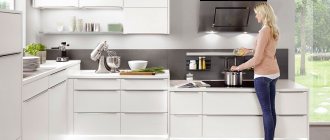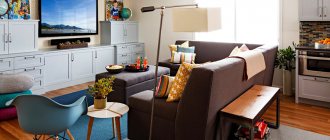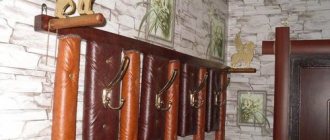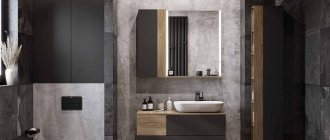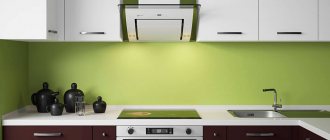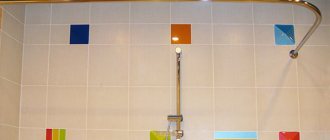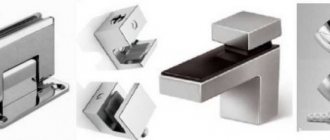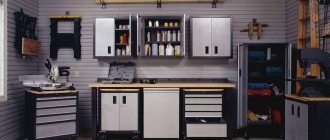A modern kitchen requires a kitchen unit. The standard distance from the countertop to the wall cabinets in the kitchen is of great importance in organizing the space. Ergonomics of the room is the basis for successful work when everything is at hand. The distance between the cabinets in the kitchen and the countertop is sometimes determined independently, focusing on the height of the housewife and family members. But there are different approaches to furniture placement.
In a private house
What should the standard height be?
Knowledge of the rules of ergonomics - the science of rational organization of the surrounding space - is useful not only at work, but also in everyday life. There are a number of important issues in arranging a kitchen that can be resolved with the help of these general recommendations, which make it possible to make the space not only functional, but also comfortable.
By calculating the average height values and furniture parameters, a certain standard was determined that gives at least some guidelines in this matter.
The standard height from the countertop to the upper cabinets is 55-60 cm.
When to follow the standard:
If your height differs significantly from the statistical average, it makes sense to calculate the distance based on individual parameters. It is also important to know the minimum acceptable value. We'll talk about this in more detail in the next paragraph.
Watch a useful video on how to mark, install and level furniture on the same level:
Standard accommodation
Kitchen furniture is developed by designers and constructors. Russian manufacturers still focus on GOST standards. Western manufacturers' furniture looks different. They have their own standards. Kitchen cabinets purchased from Ikea will be larger in size than domestic ones.
In the country
Furniture from China is somewhat smaller than its Russian counterparts. This is due to the average height of the people in whose country the product is produced. Everyone focuses on themselves. The concept of “comfortable” will be very different for people with a height of 160 and 180 cm.
Buyers need to be guided by what distance from the wall cabinets to the countertop is acceptable for them personally. The basic rule is that the bottom shelf of a wall cabinet is at the owner’s eye level.
This could be the end of the conversation about the distance from the tabletop to the hanging cabinet, but there is one circumstance. These are household appliances. Additional parameters are included in the interval between the countertop and wall cabinets.
Bright hues
This is necessary to prevent possible damage from the operation of electrical appliances:
- steam coming from an electric kettle;
- splashes from the mixer;
- heat coming from a microwave oven.
To keep furniture in good condition for many years, you need to take these negative factors into account. The standard is a distance of 50–60 cm.
This value is enough to protect furniture from steam and grease.
Layout of lower and upper drawers
How to correctly calculate the distance between the countertop and wall cabinets?
Why is it so important to do the calculation correctly? If the cabinets hang too low, you may constantly hit them with your head. Another point (in some cases very controversial) is the ease of use of the upper shelves: you should be able to easily reach for the essentials.
It is generally accepted that the upper edge should end at a level NO more than 20-25 cm above the person’s head. But this method of calculation does not work if the top row is supposed to be installed under the ceiling. Such headsets are most often made to order. In the ready-made furniture market, cabinets with a height of more than 60 cm are, as a rule, produced based on the standard distance above the working surface (60 cm) and under standard ceilings of 2.7 m. In the case of a high set, another rule applies: here it is important to take into account the level of the shelves inside and their filling.
Considering the point described above, we must conclude that when calculating the optimal distance, you need to focus on the lower limit and dimensions of the furniture itself.
Let us note the main conclusions.
The table below will help you quickly determine the optimal distance from the floor.
Along the top edge, the cabinet for the built-in hood is level with all the others.
Source
Basic rules and standards for determining mounting height
The height of the wall cabinet placement refers to 2 indicators: the distance from the floor to the bottom shelf and the upper level of placement. GOSTs have precise recommendations, but it is easier to select the parameters yourself. Construction standards differed at different times, so you will have to “take into account” the features of the premises, primarily the ceiling height. When deciding on the height of your kitchen cabinets, there are 3 main factors to consider.
The first thing to consider is the purpose of the cabinets: they can accommodate special modules. The second point is the location: above the lower tier or above free space. However, all these calculations are useless if you do not take into account the height of the person preparing the food. From a design point of view, it is easier to install standard furniture - it will fit well into the space.
Dimensions and heights of base cabinets
Gosstandart stipulates the height of the lower edge of wall cabinets at 135-150 cm if they are mounted above the floor tier. The lower cabinets are always set level, and their height is consistent with the height of the owners. Usually the result is about 85-95 cm. The distance between the tabletop of the lower tier and the lower edge of the upper one in the vast majority of cases is within 45-60 cm, and leaving less than 45 cm is unacceptable. This interval (45-60 cm) is the normal distance for an apron in the kitchen work area. In this area there should be a place for household appliances such as a multicooker, microwave, food processor. If the margin to the bottom row is too small, then a person may hit his head when washing dishes. For the convenience of tall people, the distance can be more than 60 cm. If the owners are very tall, then both the lower and upper rows of furniture are purchased much higher.
Standard dimensions of lower cabinets:
- Height - 80-95 cm.
- Depth - 50-70 cm.
- The width (of one section) is 35-80 cm. However, there are narrow options, for example, bottle holders.
The deeper the sections of the floor set, the lower the top one should be placed.
Height from floor
Regardless of whether there is a lower tier of cabinets or not, the universal rule for placing the lower edge of wall cabinets applies - it should be approximately 5-7 cm below shoulder level. In this case, it makes sense to calculate the average for all adults. If there is no lower tier, then the height of the lower edge at 130-135 cm will allow you to get accessories from the upper shelves without obstacles. It is estimated that a housewife of average height (160–170 cm) in a standing position will find it convenient to use a cabinet at a height of 1300–1900 mm. If you use a chair, the drawer at the level of 1900-2400 mm will become fully accessible to her. The placement height can be adjusted to the optimum and best visibility. For a housewife with the above parameters, these are 140 and 165 cm, respectively. For her, a height of about 180 cm separates the zones of limited (below) and least accessibility (above).
Upper limit of cabinet placement
They are based primarily on the distance between the hanging structure and the tabletop. Otherwise, everything depends on the height of the sections. However, you should initially look for options for the optimal position along the upper limit. There is no need for shelves at a height of 210-220 cm - even for tall housewives they will be uncomfortable. In kitchens with a ceiling below 2.6-2.7 m, high placement of the headset will interfere with the arrangement of the upper zone, if this was planned. In any case, before buying furniture on the wall, it is better to draw marks of the maximum allowable height at the top. It should be 20-25 cm higher than the height of the tallest family member or the average height of adults. The ideal height of the top edge of cabinets does not depend in any way on compliance with the triangle rule or the configuration of the kitchen, be it U-shaped, corner, linear or double-row.
At what height to hang kitchen cabinets - let's look at it in detail
In this article I will look at how to properly hang kitchen cabinets and at what height. I'll tell you what distance should be between the cabinet and the countertop, stove and other cabinet. I will explain whether it is necessary to pre-prepare the walls and, if necessary, how to do it. What kind of fastenings exist and how to choose them correctly, depending on the walls and the cabinets themselves, how to adjust the hinges. I will consider the entire hanging process and what nuances there are.
What should be the distance from the cabinet to the gas stove?
I have a question, we bought an apartment, the former owners left behind the kitchen set and stove, the stove is gas, so the question is this, the stove sits very tightly with the cabinet, I just know that the set should not be close to the stove, what can you come up with? , it’s impossible to move the stove and cabinet, everything is right next to the walls and to each other!?
Yes, the distance from wooden furniture to the gas stove must be at least 15 cm.
What are the possible solutions in your case:
1) Buy new furniture after all.
2) Replace part of the cabinet adjacent to the stove (tabletop and side wall) with fireproof materials (artificial or natural stone for the countertop, tempered glass, etc.)
3) You can install a protective screen, for example, made of fire-resistant glass, between the stove and the cabinet. The question, of course, is how convenient it will be for the hostess. But, safety comes first.
4) Disassemble this cabinet and make it narrower by cutting off large parts.
Here it is important to clearly know that gas stoves are completely different; if it is a modern gas stove, then open the instructions, it should clearly indicate whether installation close to furniture is possible.
The thermal insulation of more advanced models of gas stoves allows for close installation; the side walls of the stove do not get very hot even when the oven is running.
Here are some photos to prove it:
I have a stove close to the cabinet, I don’t see any problems.
It is also important to know what the furniture is made of; if it is chipboard, then it is better to give a gap (5-10 cm), because in the manufacture of chipboard, phenol-formaldehyde resins are used, which are more actively released when heated.
If MDF or natural wood and the board allow you to place it close together, then install it.
If the MDF is laminated, then a gap is also needed, because the film can come off.
Gaps are sometimes left for convenience when cleaning the stove; see for yourself, if you have a flexible gas hose, then moving the stove away is not a problem.
In regulatory documents, there is a special indication only for the distance between the back wall of the gas stove and the wall of the room, these are the following values:
- at least 100 millimeters if the walls are semi-combustible
- at least 250 millimeters if the walls are combustible
The distance can be reduced by installing a thermal insulation screen on the wall.
There is one more rule - the distance to the wall from the side wall (attention!) of the oven is at least 350 millimeters.
But these requirements date back to 1969; in more modern publications there is no information about the distance from the gas stove to the kitchen furniture, just as there is no information in the instructions for the stove.
Perhaps the lack of information is due to the fact that this distance is simply not regulated, since modern gas stoves already have a thermal insulation layer inside.
Although builders recommend maintaining 5 millimeters, it is even better to fill it with thermal insulation.
Hello! I studied the topic: complete nonsense, both in the comments and in the regulatory requirements. The first ones are often given by people who “heard the ringing. ” or “for whom the law is not a decree and everything is possible. “, the latter are mostly outdated and do not correlate with modern equipment and furniture, limiting “just in case” so that when using old things they do not cause a dangerous situation. I encountered this myself when installing a meter: dense furniture was not damaged, but the paint on the side wall of the “De Luxe” gas stove swelled and began to rust badly (there was simply no layer of primer under the paint on this wall). On the other wall, where there is soil, only two spots have swelled. The reason is overheating of the oven and defective manufacturing. In addition, heating laminated chipboard furniture produces a strong “exhaust” of phenol, and firefighters may object (according to the instructions for gas stoves, a gap of 15-50 mm is required, depending on the stove). Exit: use a gap of 15.20 mm from the sides, when installing the tabletop tightly, covering it with decor from the facade; make a gap of 5 mm and attach a metal sheet protruding into the gap to the wall to the sidewall; attach several radiator diffusers from radio or electrical equipment to the sheet; check the actual temperature of the walls with close contact before installing the furniture (some “good” slabs do not heat up more than 50 degrees C) and proceed according to the test results, even to the point of ignoring the clearance requirements; Place metal cabinets on the sides of the stove for equipment (lids, frying pans - metal), etc. But remember that harmful emissions and fire hazards must be neutralized by YOU, because YOU suffer from the consequences, and not someone who advised you to “don’t give a damn about everything, like everyone else. "
Upper cabinet height
Standard height for kitchen wall cabinets
At what height should kitchen cabinets be hung? As already mentioned, mostly kitchen furniture is made to an acceptable size. There are standards for their location.
| Bottom edge of top cabinet | Located above the tabletop at a height of 45 cm |
| Upper cabinet depth | 30 cm is less than the depth of the floor ones. If you want to build a microwave into a wall cabinet, increase the depth to 40 cm |
| Height of wall cabinets | 70 cm, largest size – 90 cm – 1 m 20 cm |
The optimal height of the top point of the wall cabinet from the countertop
But sometimes these sizes are not suitable. Then the furniture is made according to the customer’s measurements. The hood is installed above the stove: if electric - at a height of 70-75 cm, if gas - 75-80 cm. The oven or microwave is installed so that the hostess can use them without difficulty. It is not recommended to place various types of equipment in mounted modules; therefore, their width varies from 15 to 80 cm, and their depth is 37 cm.
In the case of corner kitchen cabinets, experts recommend not reducing the height above the countertop to less than 60-65 cm
Important! All wall furniture should be identical; it is this feature that will enliven the kitchen interior and make it ideal.
Approximate height of cabinets in the kitchen
The height of the wall cabinets is an important component; it determines how functional the kitchen will be. This parameter is taken into account during design. When determining all values, proceed from what you are going to store.
Wall drawers must be placed in such a way that access to the shelves above is convenient, without the use of any additional items
Installation of a stove in a private house
The installation of a gas stove in a private home is not regulated by separate rules and regulations. It is not much different from placing an appliance in the kitchen of an apartment building. However there are a few additions:
- installation is allowed in a room with a height of up to 2 m inclusive, if it has a volume of at least 1.25 times greater than that specified in clause 6 of the section “Requirements for premises”;
- in a house without a dedicated kitchen, the volume of the room should be 2 times greater than the figure specified in paragraph 6 of the section “Requirements for premises”;
- if there is a sloping ceiling with a height in the middle part of at least 2 m, installation is carried out in the part where the ceiling height is at least 2.2 m;
- when installing the device outdoors, under a canopy, make barriers to prevent the flame from being blown out by the wind;
- The same requirements apply to the placement of gas stoves in summer kitchens as for ordinary premises.
The installation and location of gas boilers intended for heating and hot water supply are subject to increased safety requirements. They are reflected in SP 402.1325800.2018.
Useful tips
Mostly useful tips concern how to install the upper cabinets of a kitchen unit. Because, as mentioned above, the reliability of fastening is the key to safe operation of furniture.
What can we say to summarize what was said above? The distance between the upper and lower elements of kitchen furniture is the most important component that determines the ease of use of the kitchen set. The choice of this value is based only on the height of the person who uses the kitchen space more often than others. Therefore, when measuring it, it is necessary to hang the upper cabinets.
How to correctly calculate the distance between the countertop and wall cabinets?
Why is it so important to do the calculation correctly? If the cabinets hang too low, you may constantly hit them with your head. Another point (in some cases very controversial) is the ease of use of the upper shelves: you should be able to easily reach for the essentials.
It is generally accepted that the upper edge should end at a level NO more than 20-25 cm above the person’s head. But this method of calculation does not work if the top row is supposed to be installed under the ceiling. Such headsets are most often made to order. In the ready-made furniture market, cabinets with a height of more than 60 cm are, as a rule, produced based on the standard distance above the working surface (60 cm) and under standard ceilings of 2.7 m. In the case of a high set, another rule applies: here it is important to take into account the level of the shelves inside and their filling.
Considering the point described above, we must conclude that when calculating the optimal distance, you need to focus on the lower limit and dimensions of the furniture itself.
Let us note the main conclusions.
The table below will help you quickly determine the optimal distance from the floor.
Along the top edge, the cabinet for the built-in hood is level with all the others.
Multi-level kitchen set
by sharing with friends, please:
Important nuances to consider when choosing height
Important aspects for determining height are:
- adult height;
- dimensions of the upper modules;
- dimensions of the lower bedside tables;
- location of the hob.
The first thing to consider is the dimensions of the furniture elements, which is why you should buy them after making preliminary calculations regarding the possible location and convenience for family members. Right at the point of sale, you can check the ergonomics of the wall and choose the configuration of the shelves. The topmost one should ideally be accessible to all adults and at least to the tallest members of the family. It is important to determine the ideal height of the kitchen apron. If nothing prevents you from conveniently working with the sink, cutting surface and hob, then you can leave only 45 cm for this element. This option is acceptable even for tall people. We should also not forget about the spaciousness of both rows of the headset, and even more so “sacrifice” it for the sake of the accessibility of the upper shelves.
Cabinet sizes
Typical parameters of kitchen wall wall cabinets are within the following limits:
- height - 35-70 cm;
- width - 15-80 cm;
- depth - 25-45 cm.
The height of the hanging tier depends on the size of the sections. And this applies not only to the upper, but also to the lower elements of the headset. The standard height of the lower tier is 80-95 cm and consists of the height of the base, frame and thickness of the tabletop. The depth of the lower cabinets is usually 55-60 cm, but it can be 10 cm less or more. The tabletop protrudes beyond the edge of the cabinets by 3-5 cm. The lower limit of the placement of the hinged structure is selected taking into account the above features. As for the upper cabinets themselves, regardless of height, they are usually aligned in a line along the top edge. It is undesirable for the bottom shelf of short drawers to be higher than 80-90 cm above the tabletop. Cabinets with a height of 70 cm are hung so that the lower edge is no more than 65 cm away from the tabletop, with 55 cm being a convenient option for most people. The second and third shelves should be at the optimal and maximum height, respectively.
Dependence on hood and stove
It is not recommended to install cabinets above the stove itself, but this can be done above the hood. This solution in the interior has already become a classic. When installing, you should take into account the minimum permissible height from the hob - 60 cm. It will most likely not be possible to hang the cabinet flush with the adjacent sections. However, this is not all the difficulties - when heated, some materials release dangerous compounds. Treated wood (for example, chipboard) can emit formaldehyde and phenols when exposed to temperature. The placement height also depends on the type of slab. It is recommended to leave a margin of 65-70 cm above the electric one, and at least 75-80 cm above the gas one. It is advisable to place the hood at this level, and cabinets a little higher. To place furniture modules above the thermal hood, special configuration options are provided.
Cabinets above the working surface of the hood practically do not increase the usable space - they usually have little space.
Taking into account a person's height
The height of adult owners must be taken into account. We measure exactly the average. Moreover, if only one person regularly cooks in the kitchen, then there is no need to take into account average height. But still, the lower the shelves, the easier they are to operate, regardless of the purpose for which they are used. So, if the average height of adults is below 178 cm, we place the lower edge of the cabinets 155 cm from the floor. With an indicator within the range of 178-185 cm, the sections are hung at a level of 160 cm. With a greater average height, the bottom of the modules should be in the corridor of 160-175 cm, in proportion to the result obtained. It is advisable that the upper shelves are located no higher than 20-25 cm above the head of the shortest adult. Shelves higher than 210 cm from the floor are non-functional. The minimum low placement of a hanging tier of furniture is 135 cm, but some recommend placing them at least 145-150 cm for people of average height.
Non-standard placement
Non-standard kitchen spaces require equally non-standard solutions. Often it is necessary to place wall cabinets in them using original methods. Sometimes this may be placement in niches, tricky work around pipes, or proximity to a boiler. It is worth noting that in such cases the cabinets are not standard, but made to order.
Recently, among the most non-standard solutions for installing hanging cabinets, the ceiling mounting option has become increasingly popular. In this case, it feels like the pieces of furniture are floating in the air. It looks especially impressive when combined with kitchen islands.
Another trend in the new season is placing the headset at different levels. Moreover, this applies not only to wall cabinets, but also to floor cabinets. However, this solution is not only original, but also practical, as it allows you to distribute the load on the spine.
To find out at what height you need to hang kitchen cabinets, see the following video.
Pipe transfer
The decision whether it is possible to cut or move the gas pipe in the kitchen will be up to the relevant services. You are only free to propose network redevelopment and voice your option. And professionals will tell you whether such changes are real, whether they will pose a threat to people’s lives, and will also tell you how much such an “upgrade” will cost you. Where to begin? Where should I knock?
Registration of permission
Remember the step-by-step instructions for preparatory actions and coordination of plans for moving gas pipes:
- Contact the gas service according to the place of registration. It happens that you need to “knock” on some subsidiary structure of this organization: they will explain everything to you on the spot.
- Filling out an application. You will be provided with a sample application, on the basis of which you must write statements on your behalf on what changes you want to make (the application serves as the basis for a specialist to visit you).
- Inspection of the home by a gas service representative. The master will listen to you, examine everything, check it, make the correct calculations (taking into account compliance with all standards). It is not a fact that the expert will reject your plan; it happens, especially with a diligent approach and the homeowner studying the rules, that the master does not have to edit anything.
- Drawing up an estimate. This is, in fact, what the office you contacted does.
- Coordination of the estimate. When the plan is ready, it will be given to you so that you can read the documents and give your consent to carry out this type of work.
- Payment. If you are satisfied with the estimate, you should pay for this service. If not, then don’t be upset, it can be improved, you just tell the master what you don’t agree with, and he will find a compromise offer.
Worth paying attention! If it is not possible/safe to make the network configuration according to the “scenario” you propose, or the estimate proposed by the service does not suit you, then it is too early to give up. Buy or order a beautiful box for the gas pipe in the kitchen, and your problem will be solved and the beauty will be increased.
Preparation for the process
If you agree on the estimate, then within 5 days (usually) a team will knock on your house, ready to move the pipes according to your wishes. Do you need to prepare for the arrival of the masters? If you want the work to be carried out quickly, efficiently, and your home not to be damaged by the workers’ visit, you should do the following:
- contact the craftsmen and find out if you need to provide any consumables (so as not to run after them while the team is working, frantically looking for someone of your own who will look after the apartment, after all, strangers are working);
- free up the space where it is planned to dismantle and install new pipes - workers must have unhindered access to the network;
- cover all kitchen surfaces, appliances and other valuable items, because the craftsmen will be cutting, cooking, dusting and littering (it is better to use coatings that are not prone to burning as a material, for example, tarpaulin, burlap);
- close the valve to stop the flow of blue fuel to the pipes.
Source
Hanging a wardrobe
The mounting rail must be secured to dowel-nails
Method 1
If there is more than one cabinet, go through all the steps for each of them. Make sure that everyone hangs at the same level - that's why you drew a horizontal line.
Fastening with dowel-nails
The second tip concerns fastening the cabinets together. They do this both for aesthetic reasons (so that they do not diverge) and for greater reliability.
Method 2
Metal mounting rail
First you need to level the wall, although we assume that after the repair they are already perfectly level.
Fastening cabinets to a special canopy
With this method, cabinets can be moved along the slats, as if on rails. However, such a design costs much more than simple screws, hooks and loops. But you don’t need to get fancy with the markings or hire an assistant. The cabinets can be moved both vertically and horizontally thanks to the rotating screws and thus align them. If the cabinet is very heavy, you can strengthen the structure by breaking the rail into pieces and attaching each with 3 screws.
This is approximately how the cabinet is attached to the mounting rail.
The mounting rail method also has its disadvantages . There will be a small space between the wall and the cabinet. Therefore, you need to nail a strip of the same thickness along the bottom of the cabinet from the back side, or hang the cabinet so that the bottom edge is on the kitchen apron.
Features of the installation process
You can’t ignore hanging cabinets; you should know a few subtleties of the work being done.
- If the modules are installed on plasterboard walls, it is advisable to decide in advance what the distance between the cabinets in the kitchen will be. This is due to the need to install a wooden block to increase the reliability of the structure.
Important! Using a butterfly dowel is not prohibited, but it is not recommended. This is too weak for kitchen cabinets.
- It is better to hang the modules on a metal guide, and install adjustable canopies in the cabinets. This will allow, if necessary, to raise or lower the kitchen top by 1.5-2 cm.
- The cabinets must be tied together with intersectional ties or wood screws. This is required for the reliability of the entire structure.
- Use high-quality fasteners, do not skimp on hardware.
For a more even hanging, you can attach a temporary strip, which will be the bottom border of the cabinets
At what height to hang kitchen cabinets: detailed information
Almost every housewife dreams of a functional kitchen. Manufacturers offer a huge number of headset models. Any consumer is given the opportunity to choose an option that is not only most convenient, but also corresponds to his taste preferences. Most modern furniture options use wall-mounted modules. To make it comfortable for a housewife to cook in the kitchen, it is important to arrange all the elements correctly. An important nuance is the height of the cabinets.
At what height should you hang kitchen cabinets?
Dimensions of base cabinets
Standard sizes of base cabinets
How tall is the hostess - this should be taken into account when designing a headset. This affects how convenient it will be when using the modules.
The correct height of kitchen cabinets, tested for the ease of performing various actions while cooking
- The height of the floor cabinets, according to standard dimensions, is 85 cm. Depending on the height of the base (its standard is 10 cm), it is made larger or smaller.
Height of kitchen cabinets from floor - The thickness of the tabletop also affects the height, which due to this parameter increases by 3-4 cm. The protrusion of the tabletop in front is 3-5 cm, behind the back wall - 5-10 cm. This allows you to hide electrical wiring, plumbing, and gas pipes.
- The optimal depth of the tabletop is 60 cm; if it is capacious, then 90 cm or 1 m 20 cm.
Depth of lower kitchen cabinets - The standard depth of base cabinets is 46 cm. If the furniture has built-in drawers, the depth of the roller guides is 45 cm plus 1 cm between them and the back wall.
- The width of the front side of the cabinet should not exceed 90 cm; therefore, the doors are made 30-45 cm wide. Internal shelves should be placed in increments of 20-30-40 cm. This distance depends on the size of the appliances and food products.
All cabinets should be the same, only this way the interior will truly become harmonious
Taking into account the area of the room and focusing on the standards, arrange the kitchen of your dreams, where you will be in a good mood cooking, spending time with friends and family over a cup of tea.
Factors influencing the location of upper cabinets
When choosing the height of wall-mounted modules, there are several aspects to consider.
The most important thing when placing kitchen modules is convenience for those who most often manage this room. As a rule, the headset consists of two levels - upper and lower. The height of the chief cook largely determines the installation height of the structures fixed on the second level.
Recommendations for the location of kitchen units
It is important that the location of the lower shelves of the upper cabinet is approximately at eye level. In this case, easy access to the most frequently needed items and products is provided. With this arrangement of the most popular storage places, it is much easier to assess the situation and find the right thing. Otherwise you will have to use some kind of stand.
Using kitchen cabinets should be convenient without additional stepladders
Hanging cabinets too low is also not recommended. This is explained by the inconvenience of working on the countertop and fewer possibilities for placing various accessories (shelves for spices, hangers for kitchen appliances, etc.) on the wall between the levels of cabinets. It is also important that all kinds of electrical appliances are often installed under wall cabinets. If the bottom surface of the module is located close to the working surface, its appearance may be affected by operating equipment (not to mention the increased level of fire hazard). Steam from a kettle or multicooker will ruin the coating in a short time.
It is important to choose the optimal height of cabinets to accommodate electrical appliances
When choosing the arrangement of modules and their sizes, the height of the ceilings in the room is of great importance. Spacious kitchens allow the designer to place all pieces of furniture, including hanging ones, focusing on considerations of aesthetics and convenience. In conditions of limited space, it is necessary to order smaller modules or place standard ones at a minimum height from the tabletop.
An example of a cabinet location above a hood
In this regard, it is important to understand what standards of kitchen cabinets manufacturers offer.
Premises requirements
Gone are the days when tiny Khrushchev-era kitchens quietly placed four-burner gas stoves by the window, next to hanging curtains. Now the situation has changed . A new regulatory document has been approved and put into effect - SP 402.1325800.2018 “Residential buildings. Rules for the design of gas consumption systems."
It includes a number of requirements for premises in which gas stoves are allowed to be installed:
- purpose of the premises - kitchens, kitchen-dining rooms, corridors;
- ceiling height - at least 2.2 m;
- the presence of natural ventilation, an exhaust ventilation duct and a window with an opening sash or window;
- the door from the room opens outward;
- there is a gap of at least 0.02 m² between the floor and the door leaf (for air flow);
- minimum room volume: for two-burner stoves - at least 8 m³, for three-burner stoves - at least 12 m³, for four-burner stoves - at least 15 m³;
- window glazing area - at the rate of at least 0.03 m² per 1 m³ of room volume (glass acts as an easily removable enclosing structure in the event of an explosion).
These requirements apply to both free-standing and built-in devices.
Standard sizes of kitchen units
As already noted, kitchen furniture modules can be placed on the upper and lower levels. Their typical sizes were determined taking into account the average physiological characteristics of a person, mainly his height.
Kitchen unit dimensions
GOST regulates standards for certain dimensions of interior items installed in the kitchen.
Table. Standards set for kitchen cabinets.
| Parameter | Size, mm |
| Module height (including table top) | 850. 900 |
| Tabletop depth | 600 |
| Depth of the lower cabinet (internal), not less | 460 |
| Depth of wall module (internal), not less | 270 |
| Height from floor to top shelf of wall cabinet, no more | 1900 |
Kitchen furniture dimensions
Dimensions of lower modules
When purchasing standard furniture, you need to pay attention to the following characteristics:
Important! Recently, multi-level work surfaces have become popular among designers. This is due to the fact that it is more convenient for housewives to perform various operations when preparing food at different levels. For example, it is comfortable to process food at a height of 90 cm, to wash dishes at a level of 100 cm, and to cook on a stove with a hob installed at a distance of 80 cm from the floor.
Dimensions of suspended structures
The standard dimensions of the upper modules are also designed for the average housewife.
Upper kitchen modules
The distance between the shelves in the cabinet can be 20 or 30 cm. Despite the fact that current standards determine the maximum height of the top element to be 190 cm, however, it is also possible to exceed this parameter. In addition, wanting to make maximum functional use of the entire space of a small kitchen and installing structures almost to the ceiling, many deliberately resign themselves to possible difficulties.
Cabinet sizes and ease of use
Today, interesting solutions are offered for organizing access to areas of wall cabinets suspended high. For example, the installed electric drive allows you to press the button (in some models you can simply pull the handle) to lower the top shelf down to the required distance.
Lift system for kitchen cabinets
A stepladder that extends (after pressing the keys with your foot) from the lower cabinet also helps to operate all the compartments of the wall cabinet as needed. In this case, there is a big disadvantage of the design - the device hidden in the module takes up space that could be used for storing kitchen utensils or installing equipment. Designs that fold into drawers have also been developed.
The design of a kitchen set may involve various ways of installing wall-mounted structures:
Of course, if there is such an opportunity, it is more convenient to order furniture with individual parameters. In this case, you can easily take into account the wishes of the hostess and use the available space as functionally as possible.
Installation height of upper level cabinets
To make it convenient to work in the kitchen and to place household appliances on the countertop, you should not hang the cabinet below 45 cm from the work surface. If the owner's height exceeds average, this parameter can be increased to 60 cm.
Installation height of upper level cabinets
There is a dependence of the installation height of the modules (lower part) on the height of the main cook.
Table. Distance from the bottom surface of hanging cabinets to the floor.
| Man's height | Distance, cm |
| 175. 178 | 150 |
| 185 | 160 |
| 200 | 175 |
When installing cabinets in which exhaust devices are built-in, the standards for the placement of this equipment become decisive. In kitchens with gas stoves, hoods cannot be installed lower than 75 cm above the hob. If we are talking about electric stoves, then it is recommended to maintain at least 65 cm.
The upper modules can be mounted on a wall where there are no floor cabinets or work surface. In this case, they are guided by the ergonomics and design of the entire headset. The same principle is used when installing furniture above appliances (refrigerators, ovens, microwave ovens, etc.).
Wall cabinets in the kitchen
When calculating the distance from the tabletop to the bottom of the hanging furniture, first of all you need to focus not on the rules, but on your preferences. Despite accepted standards, some install cabinets at a height exceeding 70 cm. This is more convenient for them.
Incorrectly placed upper modules can significantly complicate the cooking process for the housewife. This not only leads to rapid fatigue, but is also fraught with injury. There are often cases when a cook hits a cabinet with his head. One of the reasons for the problem is the low location of the piece of furniture.
Important! Before ordering furniture, you need to prepare a drawing in order to correctly calculate all the parameters.
What to do if the modules are at different levels
The design of a kitchen set sometimes involves multi-level modules. This furniture looks unusual and elegant. In this case, focus on the lower shelves. The rule here is that it won’t be difficult to reach them.
Variety of heights
Longer items are hung higher, so that the lower shelf is accessible. Sometimes furniture modules can be hung at the same height level.
Then the long sections are placed below 45 cm from the tabletop.
There's nothing wrong with that. The main thing is to plan the space so that nothing is placed under these sections.
Planning plays a crucial role in the placement of kitchen utensils. Well-accessible cabinets and drawers house items that are used frequently. Things that are rarely needed are put on the top shelves.
In the village
Do-it-yourself wall cabinet mounting
You can install the upper modules of the kitchen unit yourself, without resorting to the services of professional teams. To do this, it is important to have the necessary tool and have minimal skills to work with it. In addition, it is necessary to consider the fastening system.
Fixing the cabinet on the wall can be done in two ways:
Kitchen Cabinet Fasteners
The first method, despite the more expensive parts, is considered the most reliable and convenient. All work can be done alone, and aligning the modules is easier. Dismantling of structures suspended on the bar is also easy.
Installation of kitchen cabinets on a strip
Important! The work of installing cabinets should be treated responsibly, since incorrect calculations can worsen the perception of the entire installed set, and poor fastening can cause the collapse of the structure.
To install the upper modules, you need to prepare the following tools and accessories:
To fix the cabinet, universal canopies are used (2 pieces per cabinet).
The great advantage of such devices is the ability to adjust the installation level of the cabinet in terms of reach and height. Canopies can be right or left, as well as universal.
In addition, you will need self-tapping screws: with dowels for mounting the tire (for greater reliability, you can replace them with anchor bolts) and for attaching canopies.
Step 1.
Tire installation markings are made using the level. The bar itself can be broken off using the notches on it. Many people use separate tires for each canopy for installation. However, for convenience, it is recommended to mount a solid rail across the entire width of the modules. This will immediately ensure the correct installation level.
Marking the tire installation using a laser level. Marking fastening points
Step
3.
To fix the tire, you need to drill holes. The wall can be made of different materials. The vast majority of load-bearing structures are made of reinforced concrete. The cabinet is installed on such bases using dowels with a diameter of 6 mm and self-tapping screws of 4 mm.
Slots in the back wall of the cabinet can be made with a jigsaw or hacksaw
Fastening the back wall of the cabinet
You can pull it closer to the wall by tightening the end bolt.
Adjustment by tightening the bolt
Now the cabinet will not be able to jump off the mounting, even if it is accidentally lifted a little. Height adjustment is carried out using the second bolt.
Height adjustment
The wall cabinet is securely mounted on the kitchen wall.
In order for the dimensions of kitchen structures to best meet the requirements of household members, it is recommended to order designs according to your individual requirements. However, this option is more expensive. If you want to save money, you can purchase standard modules. In this case, you need to consider the proposed options and carefully calculate the installation method to choose the optimal one.
Installation standards
The rules for installing gas stoves or built-in gas panels are described in detail in the instructions from the manufacturer. The technical characteristics of each type of burner are also given there.
Important! Installation of any gas-using equipment, including stoves, is carried out by a specialized organization that has a license for this type of work. If the device is connected by unqualified personnel, there is a risk of gas leakage and explosion. Independent installation and connection of gas-using equipment, which includes stoves, is considered a violation. The consumer is only allowed to perform actions that are performed without a tool.
The work is carried out according to the manufacturer's instructions, taking into account the existing technical connection conditions and the requirements of the local gas service in the following order:
- Make sure that the stove complies with GOST 33998-2016 and is equipped with a “gas control” system that stops the gas supply to the burner when the flame goes out.
- Before installation and connection, check that the type and pressure of gas in the local gas network are compatible with the settings of the device. If necessary, adjust to a different type of gas by replacing the nozzles.
- The device is placed in a strictly horizontal position using set screws and legs.
- Connect the equipment to gas using certified flexible hoses, which should not touch the heated back wall of the appliance and the top of the oven.
- A dielectric insert is placed between the gas tap and the hose, meeting the standards for interrupting the current and passing the full gas flow.
- Seals are used only once.
- After installation, check the tightness of the connections made with a soapy sponge. Apply soap foam to the connection points and see if air escapes.
- Light all burners, checking the stability of the flame at low and high temperatures.
